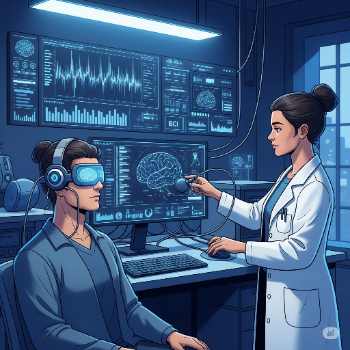Brain-Computer Interfaces for Research allow direct access to real-time brain activity. This provides clearer insights into thoughts and emotions. As a result, BCIs are changing how researchers study the mind in fields like neuroscience, psychology, and human-computer interaction (HCI).
Are Brain-Computer Interfaces (BCIs) the Future of Research?
Absolutely, Brain-Computer Interfaces (BCIs) are revolutionizing scientific research. For instance, these systems capture brain signals directly, providing researchers with clear, real-time, and human-focused data. Consequently, BCIs enable deeper exploration of the mind across fields like neuroscience and psychology.
BCIs were once used mainly for clinical and assistive purposes. Now, they’re transforming mainstream research. They replace older methods like surveys, observations, and physiological sensors. Consequently, they offer a clearer view of human behavior, thoughts, and emotions.
What Are Brain-Computer Interfaces (BCIs)?
BCIs are advanced tools that connect the brain directly to external systems. They function by detecting brain signals and converting them into digital commands, usually through non-invasive devices like EEG headsets.
It was first created to help people with motor impairments. Now, they are used in various research areas, like psychology, marketing, and human-computer interaction. For instance, researchers apply BCIs to study behavior and emotions more effectively.
Why Use BCIs in Scientific Research?
It enables researchers to capture brain activity non-invasively and in real time, even in everyday settings. Unlike traditional methods, they provide direct access to cognitive and emotional data that was once out of reach.
Key Benefits of Using BCIs in Research
-
Real-Time Cognitive Tracking
BCIs can track mental states like tiredness, focus, and memory use. They do this with great accuracy. For example, they measure these states in milliseconds. As a result, you can understand the brain in real time. -
Emotion Recognition
BCIs can sense emotions directly. You don’t need self-reports or behavior observation. For example, this method provides clearer insights. As a result, you better understand how someone truly feels. -
Dynamic Experimentation
Adapt interfaces or test settings instantly. Use real-time brain activity to guide the changes. -
Motor and Neurorehabilitation Research
Study imagined or attempted movements. For example, this helps research on stroke and paralysis
Basically, BCIs help researchers see what people think or feel. They do this in real time. For instance, BCIs go beyond what people say or do.
How Do BCIs Work?
BCIs pick up brain signals using simple tools like EEG. These tools are non-invasive. Next, the signals are processed. Then, they are turned into data or commands for systems.
Core Components of a BCI System:
-
Signal Acquisition
EEG sensors collect raw brainwave data. -
Signal Processing
Algorithms filter noise and extract meaningful patterns. -
Data Interpretation
Signals are converted into actionable information. -
Feedback Mechanism
The system reacts to the user’s brain activity in real time.
As a result, this process enables smooth interaction between brain signals and digital systems.
Major Advantages of BCIs in Research
-
Direct Access to Brain Data
No need for verbal input or behavioral observations. -
Immediate Feedback
Capture reactions as they occur. -
High Precision
Deliver detailed insights into cognitive and emotional states. -
Inclusive Participation
Enable studies involving participants who cannot communicate conventionally.
Real-World Applications of BCIs in Research
Neuroscience & Psychology
Track cognitive load, emotional responses, and attention shifts in real-time as participants engage with stimuli like videos or decision-making tasks.
Human-Computer Interaction (HCI)
Measure user frustration, confusion, or interest through brain signals to improve UX/UI design and develop adaptive systems.
Marketing & Consumer Behavior
Use neuromarketing to evaluate subconscious reactions to ads, branding, or product designs—minimizing verbal bias.
Education & Learning Science
Assess student engagement and fatigue during digital lessons or exams, and tailor instructional design using neural feedback.
Current Challenges of BCIs
Despite their promise, BCIs face several limitations:
-
Technical Barriers
Brain signals are noisy and require complex processing. -
Cost and Accessibility
High-quality BCI systems are still expensive and not widely available. -
Privacy Concerns
Brain data is deeply personal; ethical handling and user consent are essential. -
Comfort Issues
Devices may be bulky or uncomfortable during long sessions. -
Interpretation Limits
Some neural signals are still poorly understood or hard to decode.
What’s Next for BCIs in Research?
As BCI technology evolves, we can expect:
-
Affordable Devices
Wearable EEG headsets are becoming more accessible. -
Advanced Analysis Tools
AI and machine learning will enhance brain data interpretation. -
Cross-Disciplinary Integration
Fields like education, gaming, and social sciences will benefit from deeper insights. -
Stronger Ethical Frameworks
Regulations will be critical to ensure safe and responsible use.
In the near future, using BCIs in research could become as common as using eye-tracking or heart rate monitors.
Conclusion
BCIs are no longer just science fiction. They’re now increasingly used in research. These devices capture brain data in real time. For example, they help researchers study attention, emotion, learning, and decision-making.
Although there are challenges, the potential of BCIs is clear. In fact, they allow researchers to collect rich, direct data. As a result, BCIs are helping shape the future of research.


